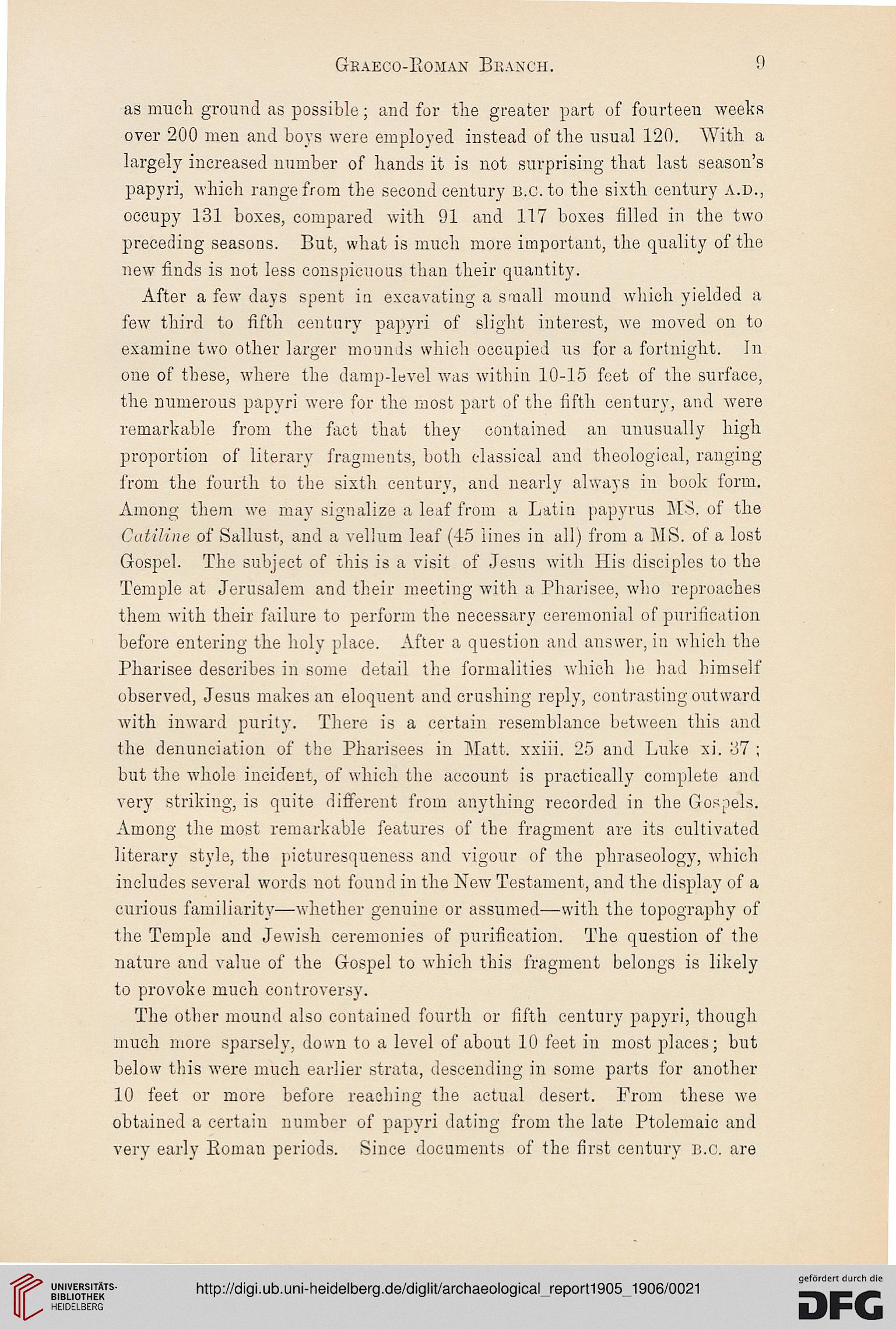Graeco-Koman Branch.
9
as much ground as possible; and for the greater part of fourteen weeks
over 200 men and boys were employed instead of the usual 120. With a
largely increased number of hands it is not surprising that last season's
papyri, which range from the second century b.c. to the sixth century a.d.,
occupy 131 boxes, compared with 91 and 117 boxes filled in the two
preceding seasons. But, what is much more important, the quality of the
new finds is not less conspicuous than their quantity.
After a few days spent in excavating a small mound which yielded a
few third to fifth century papyri of slight interest, we moved on to
examine two other larger mounds which occupied us for a fortnight. In
one of these, where the damp-level was within 10-15 feet of the surface,
the numerous papyri were for the most part of the fifth century, and were
remarkable from the fact that they contained an unusually high
proportion of literary fragments, both classical and theological, ranging
from the fourth to tbe sixth century, and nearly always in book form.
Among them we may signalize a leaf from a Latin papyrus MS, of the
Catiline of Sallust, and a vellum leaf (45 lines in all) from a MS. of a lost
Gospel. The subject of this is a visit of Jesus with His disciples to the
Temple at Jerusalem and their meeting with a Pharisee, who reproaches
them with their failure to perform the necessary ceremonial of purification
before entering the holy place. After a question and answer, in which the
Pharisee describes in some detail the formalities which he had himself
observed, Jesus makes an eloquent and crushing reply, contrasting outward
with inward purity. There is a certain resemblance between this and
the denunciation of the Pharisees in Matt, xxiii. 25 and Luke xi. 67 ;
but the whole incident, of which the account is practically complete and
very striking, is quite different from anything recorded in the Gospels.
Among the most remarkable features of the fragment are its cultivated
literary style, the pieturesqueness and vigour of the phraseology, which
includes several words not found in the New Testament, and the display of a
curious familiarity—whether genuine or assumed—with the topography of
the Temple and Jewish ceremonies of purification. The question of the
nature and value of the Gospel to which this fragment belongs is likely
to provoke much controversy.
The other mound also contained fourth or fifth century papyri, though
much more sparsely, down to a level of about 10 feet in most places; but
below this were much earlier strata, descending in some parts for another
10 feet or more before reaching the actual desert. From these we
obtained a certain number of papyri dating from the late Ptolemaic and
very early Boman periods. Since documents of the first century b.c. are
9
as much ground as possible; and for the greater part of fourteen weeks
over 200 men and boys were employed instead of the usual 120. With a
largely increased number of hands it is not surprising that last season's
papyri, which range from the second century b.c. to the sixth century a.d.,
occupy 131 boxes, compared with 91 and 117 boxes filled in the two
preceding seasons. But, what is much more important, the quality of the
new finds is not less conspicuous than their quantity.
After a few days spent in excavating a small mound which yielded a
few third to fifth century papyri of slight interest, we moved on to
examine two other larger mounds which occupied us for a fortnight. In
one of these, where the damp-level was within 10-15 feet of the surface,
the numerous papyri were for the most part of the fifth century, and were
remarkable from the fact that they contained an unusually high
proportion of literary fragments, both classical and theological, ranging
from the fourth to tbe sixth century, and nearly always in book form.
Among them we may signalize a leaf from a Latin papyrus MS, of the
Catiline of Sallust, and a vellum leaf (45 lines in all) from a MS. of a lost
Gospel. The subject of this is a visit of Jesus with His disciples to the
Temple at Jerusalem and their meeting with a Pharisee, who reproaches
them with their failure to perform the necessary ceremonial of purification
before entering the holy place. After a question and answer, in which the
Pharisee describes in some detail the formalities which he had himself
observed, Jesus makes an eloquent and crushing reply, contrasting outward
with inward purity. There is a certain resemblance between this and
the denunciation of the Pharisees in Matt, xxiii. 25 and Luke xi. 67 ;
but the whole incident, of which the account is practically complete and
very striking, is quite different from anything recorded in the Gospels.
Among the most remarkable features of the fragment are its cultivated
literary style, the pieturesqueness and vigour of the phraseology, which
includes several words not found in the New Testament, and the display of a
curious familiarity—whether genuine or assumed—with the topography of
the Temple and Jewish ceremonies of purification. The question of the
nature and value of the Gospel to which this fragment belongs is likely
to provoke much controversy.
The other mound also contained fourth or fifth century papyri, though
much more sparsely, down to a level of about 10 feet in most places; but
below this were much earlier strata, descending in some parts for another
10 feet or more before reaching the actual desert. From these we
obtained a certain number of papyri dating from the late Ptolemaic and
very early Boman periods. Since documents of the first century b.c. are





